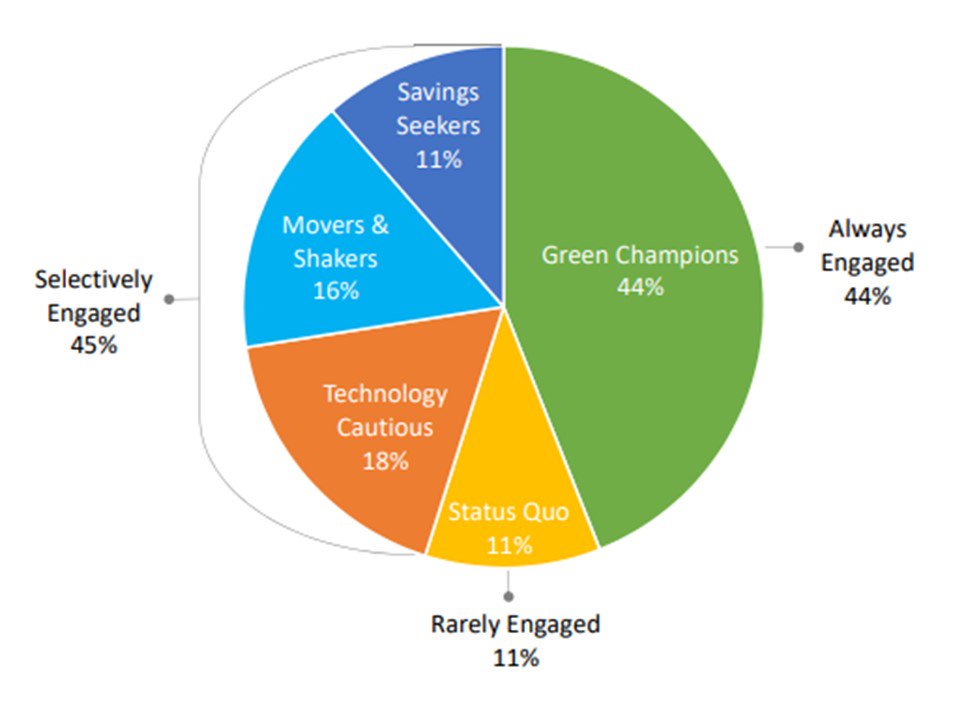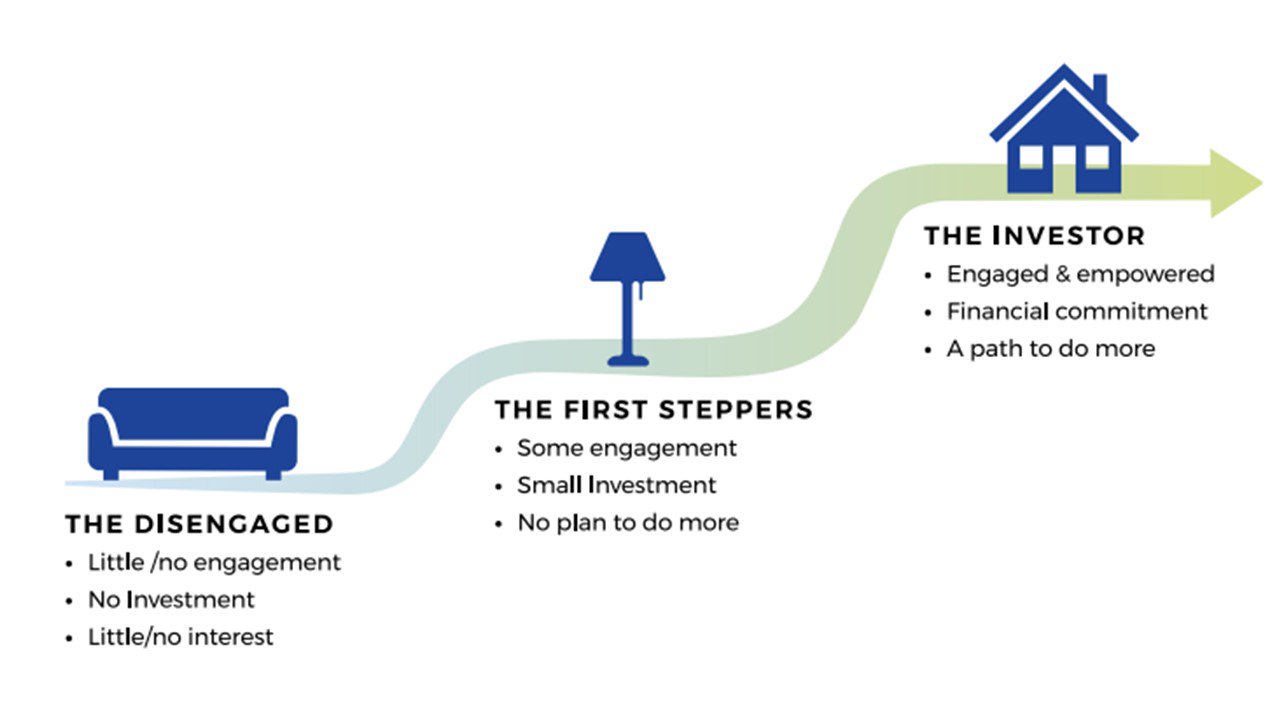In the U.S. power system’s transformation, customers’ traditional dependence on utilities is increasingly becoming a utility dependence on customers.
This reversal is driven by diminishing electricity sales caused in part by the rising reliability and affordability of customer-owned distributed energy resources (DER) and energy efficiency technologies. Forward-thinking utilities see billions of dollars in potential new revenue streams in customer demand for these retail market products. But while vendors like Sunrun and Tesla are seeing increasing business with their home solar and storage products, utilities face the challenge of reluctant, or “selectively engaged,” customers.
Over 40% of utility customers are considered selectively engaged because they are unlikely to respond to utilities’ online and digital marketing, a January Smart Energy Consumer Collaborative report found. More engaged customers, motivated by environmental or pocketbook concerns, are increasingly responding to new and traditional forms of utility messaging.
“We are moving away from an industry where the kWh was the commodity and the customer just paid the bill,” SECC CEO Patty Durand told Utility Dive. “We are moving into a new world where the utility needs to know what customers value so it can offer them products and services and become their partner.”
The monthly bill remains most customers’ main contact with utilities, but most would like electricity providers to show them “choices that align with their personal priorities,” an August 2018 SECC customer survey found. In response, many utilities are using new digital approaches to customer engagement.
“Utilities are still smoothing out digital (or self-serve) customer journeys for basics such as starting or stopping service and outage communications.”

Aida Hakirevic
Director, Navigant
Engaging customers at the retail level with products like smart thermostats and electric vehicle charging stations is expected to drive “at least one trillion dollars” of investment from utilities and other stakeholders in 2030, according to a July 2018 Navigant paper. This shift to retail could be “a billion-dollar market by 2030” for utilities and technology vendors.
To get their share of that opportunity, utilities must overcome the reluctance of the selectively engaged by taking them on a three-step journey:
- personalize messaging;
- provide useful information; and
- deliver customer benefits.
Capturing the new opportunity
The DER and energy efficiency products and services customers want “are increasingly restructuring power markets” and customers are the only stakeholders besides regulators “critical” to this transformation, according to a June 2018 Navigant industry survey.
But it is “the reality” that many customers have not yet been effectively engaged, Navigant Director Aida Hakirevic emailed Utility Dive. “Utilities are still smoothing out digital (or self-serve) customer journeys for basics such as starting or stopping service and outage communications.”
More “sophistication” in customer engagement will be necessary, because “gone are the days of the monolithic ratepayer,” the Navigant paper reported. But a paradigm shift can create new revenue streams from providing new retail products and services to a new generation of customers that already expects the access they get with Amazon, Netflix and Uber, it added.
“Utilities have catching up to do to meet those expectations,” Hakirevic said. Both Google Director of Global Energy and Enterprise Partnerships Jeff Hamel, who focuses on customer engagement, and leading customer engagement technology provider Bidgely’s CEO Abhay Gupta agreed.
To win customers’ trust, “use data to convince them of the need and the potential savings,” Gupta told Utility Dive. “Then tell them they can also get a rebate.”
Google is “leaning in” on identifying “moments that matter” when customers are making energy-related decisions, Hamel told Utility Dive. “That is when utilities can connect with them.”
Utilities’ traditional focus on safety, reliability and affordability will no longer be enough because their new customers will expect “sustainability, flexibility, autonomy and individualization,” the July Navigant paper said. To achieve this, utilities will need to use “digital connectivity.”
This can “unlock value” by bringing DER and energy efficiency technologies to homes and smart cities, the paper said. It can also create revenue streams from supplying smart charging infrastructure and electricity for transportation electrification and other new demands.
These assets’ “sensors, communications capabilities and distributed computing capabilities” will deliver “a torrent of data,” Navigant said. With it, utilities can “offer new products and services through sophisticated insights, and improve the operations of the grid.”
Each engaged customer “is a resource for the utility business, and that resource has value to the electrical grid,” Google’s Hamel agreed. “We are talking about engagement because engagement equals value for the utility and for society.”
To engage the newest generation of utility customers and achieve these objectives, utilities must “be obsessed with customers, data, and needs,” the July Navigant paper stressed.
“Waiting for customers to come to the utility does not work,” SECC Deputy Director Nathan Shannon told Utility Dive. Effective engagement requires personalized messages directed to identified customer segments through channels they prefer.
But SECC’s survey found over 40% of utility customers cannot be segmented and reached by a Navigant-type approach that targets the digitally engaged, SECC’s Durand said. Those customers also prefer bricks and mortar stores to shopping online and have not been engaged by their utilities’ offerings.

The SECC paper defines the ‘selectively engaged’ group as nearly half of utility customers.
The selectively engaged customer
Selectively engaged customers are “more likely to own a single-family home built before 2000” and “tend to be 45 or more years old,” SECC reported. They have “average or below-average annual household incomes,” typically below $75,000 annually, and “tend to not have a college degree.”
They are not among SECC’s “Green Champions” segment who respond to environmental messages through digital channels, SECC found. But the selectively engaged are also unlike the “Status Quo” segment because they are “moderately satisfied” rather than disdaining their utilities, and they have “taken steps toward being energy efficient.”
But the selectively engaged do not “look to their utility for information” or “financing options” when an energy-related home upgrade is needed, SECC reported. And, like the “Technologically Cautious,” “Savings Seekers,” and “Movers and Shakers” segments, upgrades become a priority only when the opportunity for savings is made clear, SECC found.
The primary reasons these customers are not engaged are “it’s too complicated” and “I don’t have the time,” Durand said. “And our research suggests the way around those pain points is making participation easier and barrier-free.”
They can be engaged through a three-step journey, Durand added. Effective messaging through the right channels can turn the “on the couch” disengaged who have made no energy-related upgrades into “first steppers” making small, unplanned purchases. With effective approaches, they can become “energy investors” who make planned commitments to new technologies.

The three-step journey
Reaching the selectively engaged
A common “easy and barrier-free” way to start selectively engaged customers on the journey are home lighting upgrades, Durand said. The offer can be made through in-store presentations or mailings. Education should be included, but lengthy forms requiring customer details should be avoided. Duquesne Light, PPL Electric Utilities and FirstEnergy have had success with these programs.
PPL Electric Utilities has distributed more than 37,000 free energy efficiency kits through direct mail and community organizations with a 98% customer satisfaction rating, its spokesperson Joe Nixon told Utility Dive via email.
Duke Energy customers have expressed “unsolicited appreciation” for its free LED program, Michael Keller, Duke’s customer insights and operations manager, told Utility Dive.
“There are first products, simple things like GE’s smart LED lightbulb, that can begin the journey,” Google’s Hamel agreed. They can lead to the purchase of more advanced integrated devices, like smart thermostats.
Of the barrier-free ways of reaching selectively engaged customers, on-bill financing can be especially impactful, Durand said. “Energy efficiency upgrades like double-pane windows and attic insulation can be expensive and low- and middle-income customers often don’t have that cash.”
“Zero-interest on-bill financing could allow customers to see the utility as a partner and incline them to look to the utility on other energy decisions, like smart thermostats, electric vehicles, rooftop solar or selecting a time of use rate plan.”

Patty Durand
CEO, Smart Energy Consumer Collaborative
On-bill financing allows utilities to leverage their balance sheets to provide customers with funding to make home improvements, SECC reported. With the Pay As You Save (PAYS) strategy, the monthly bill payment can include the loan repayment, which can be less than the savings from the efficiency upgrades.
Over half of the selectively-engaged customers surveyed by SECC “expressed interest in on-bill financing if the interest rate is favorable,” Durand said. “Zero-interest on-bill financing could allow customers to see the utility as a partner and incline them to look to the utility on other energy decisions, like smart thermostats, electric vehicles, rooftop solar or selecting a time of use rate plan.”
Except for small-scale programs by electric cooperatives, on-bill financing is a little-used engagement approach, Durand said.
“No investor-owned utility I know of has enrolled over 3% of members,” Environmental and Energy Study Institute program director John-Michael Cross agreed.
Southern California Edison’s (SCE) on-bill financing program for energy efficiency improvements has exceeded expectations, with 2,036 zero-interest loans for $78,671,824 and a default rate of less than 1%, SCE spokesperson Ron Gales emailed Utility Dive. It was designed to match the loan repayment amount to the bill savings. But it has not been used by more than 3% of SCE customers, he acknowledged.
“On-bill financing is an effective engagement strategy,” Bidgely’s Gupta said. “But it can be more effective if it is offered for programs that personalized data shows are valued by the customer.”
Google’s Hamel disagreed. “It has not gotten traction with utilities because the $50 price of a lighting product or a $150 thermostat do not justify the hurdles and friction it adds to the transaction,” he said. “Other ways to help customers afford these products, like direct install programs and manufacturer-supported rebate programs, are bringing prices down so low customers don’t need financing.”
A utility on the journey
The Sacramento Municipal Utility District (SMUD) does not use the term selectively engaged, but SMUD Marketing Supervisor Jason Cassella immediately recognized the customer type.
SMUD has developed personalized digital communications and social media strategies, radio, TV, print ads and direct mail campaigns, Cassella told Utility Dive. “But we have point-of-purchase displays about our rebates in front of customers shopping at retail outlets, too.”
SMUD prefers discounts and rebates to on-bill financing, but its success in engagement was demonstrated by 2018 awards from J.D. Power and Cogent Reports for customer satisfaction, Casella said. “Our holy grail is having personalized messages in the right channel at the right time, and we are constantly testing and adjusting our strategy to accomplish that.”
Its engagement strategy matches SECC’s journey. “Once a customer engages with us, we see it as an opportunity to engage more,” Cassell said. “Depending on the product or service, we may circle back to let them know the impacts of their participation. We first use the channel they engaged with us through, but we might then use associated channels.”
“We value flipping a switch and having the lights come on. But utilities that succeed going forward will demonstrate to customers that they offer value beyond the core commodity of electrons.”

Jeff Hamel
Director of Global Energy and Enterprise Partnerships, Google
The three-step journey is critical, Bidgely’s Gupta said. It begins with personal information obtained from a customer purchase or from a utility-initiated online or paper communication. The next step is educating the customer that other technologies can deliver significant returns on their investments.
The third step is a personalized offer of a product or service, Gupta said. “And making that offer without taking the first two steps is hitting your head against a wall.”
Engagement and change
“There are a lot of ways to start simple and move the customer to seeing the utility as a partner and advisor,” Durand said. “There will be a time when people go to their utilities for energy-related products and services the same way they go to Amazon.”
They will be more engaged “partly in response to pressure on the planet from climate change, and partly because of pocketbook issues,” Durand said. With 60 million households expected to use voice-enabled technologies by 2022, a potentially idle or random question about a bill can lead to a personalized response from the utility, an interaction about potential savings, and a purchase.
More and more utilities are using voice as an engagement channel, Google’s Hamel agreed. But the ongoing challenge for incumbent utilities is to make clear their relevance to their customers, he added. “We value flipping a switch and having the lights come on. But utilities that succeed going forward will demonstrate to customers that they offer value beyond the core commodity of electrons.”

